Beware the Hidden Health Dangers of Asbestos Fibers

In the not-so-distant past, asbestos was regarded as a miracle material, prized for its fire resistance, durability, and insulation properties. It found widespread use in various industries, including construction, shipbuilding, and manufacturing. However, the dark side of asbestos soon emerged as its health risks became apparent. Today, asbestos is no longer used in buildings, and for good reason. In this article, we will explore the rise and fall of asbestos as a building material, the health risks associated with it, and the transition to safer alternatives in modern construction practices.
The Asbestos Era
Asbestos enjoyed a long and illustrious history dating back thousands of years. Its fireproof and insulating properties made it a favorite in construction, particularly during the 20th century. It was used in roofing, insulation, flooring, pipes, and a wide range of building materials. The affordability and abundance of asbestos further fueled its popularity.
The Health Hazards Unveiled
Despite its versatility, asbestos had a hidden danger lurking within its fibers. Prolonged exposure to airborne asbestos fibers was found to cause severe health issues, including asbestosis, lung cancer, and mesothelioma. Workers in industries like construction, shipbuilding, and manufacturing faced the highest risks, as they often encountered asbestos on a daily basis in workplaces, offices and even in apartment buildings.
The health implications of asbestos exposure became increasingly evident in the mid-20th century, leading to a wave of lawsuits and regulations. Governments and organizations around the world began recognizing the urgent need to phase out the use of asbestos and protect workers and the general population from its harmful effects.

The Transition Away from Asbestos
The shift away from asbestos in construction materials began in earnest during the latter half of the 20th century. Several key factors contributed to this transition:
Health Concerns: Mounting evidence of asbestos-related diseases prompted governments and regulatory bodies to impose strict regulations on its use. This included guidelines for safe handling and disposal.
Legal Actions: Numerous lawsuits against asbestos manufacturers and product users led to substantial financial liabilities. This legal pressure encouraged companies to seek alternatives.
Safer Alternatives: As technology advanced, safer and more effective building materials and insulation options became available, reducing the reliance on asbestos.
Public Awareness: The growing public awareness of asbestos-related health risks led to demand for asbestos-free products.
Strict Regulations: Stringent regulations and laws were put in place to protect workers and the general public from asbestos exposure. These regulations have become standard practice in the construction industry.
Modern Building Materials
Today, asbestos is no longer used in the construction of new buildings. Safer alternatives have taken its place, and builders and contractors have embraced these materials for various reasons:
Health and Safety: The primary reason for the abandonment of asbestos is the protection of human health. The risks associated with asbestos exposure are well-documented, and responsible construction practices prioritize safety.
Legal Compliance: Compliance with asbestos regulations and laws is a legal requirement. Building codes and occupational safety standards strictly prohibit the use of asbestos in construction materials.
Advances in Technology: Advancements in material science have led to the development of safer and more efficient insulation and fireproofing options, rendering asbestos obsolete.
Public Awareness: The public is increasingly aware of the dangers of asbestos, and there is a growing demand for buildings that are free from this hazardous material.
Asbestos, once hailed as a versatile and invaluable building material, has fallen from grace due to its devastating health risks. The transition away from asbestos in construction is a testament to society’s commitment to protecting the health and well-being of workers and the public. Today, we have a clear understanding of the dangers associated with asbestos, and strict regulations ensure that it is no longer used in buildings. As we continue to advance in materials science and construction practices, the legacy of asbestos serves as a stark reminder of the importance of safety and responsible innovation in the built environment.
AsbestosGuide.org is a comprehensive online resource dedicated to providing valuable information and guidance regarding asbestos, its risks, and its safe management. This website serves as a vital tool for individuals, homeowners, and professionals seeking to understand the dangers associated with asbestos exposure and how to protect themselves and others. With a wealth of informative articles, resources, and expert advice, AsbestosGuide.org plays a crucial role in raising awareness about asbestos-related health hazards and promoting safe practices for handling this hazardous substance. Whether you’re a concerned homeowner, a renovator, or someone working in industries where asbestos exposure is a concern, AsbestosGuide.org offers a wealth of knowledge to help you make informed decisions and safeguard your health.




